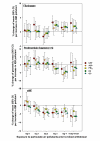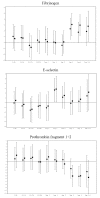Short-term effects of air pollution: a panel study of blood markers in patients with chronic pulmonary disease
- PMID: 19781092
- PMCID: PMC2762952
- DOI: 10.1186/1743-8977-6-25
Short-term effects of air pollution: a panel study of blood markers in patients with chronic pulmonary disease
Abstract
Background: Growing evidence indicates that ambient air pollution is associated with exacerbation of chronic diseases like chronic pulmonary disease. A prospective panel study was conducted to investigate short-term changes of blood markers of inflammation and coagulation in response to daily changes in air pollution in Erfurt, Germany. 12 clinical visits were scheduled and blood parameters were measured in 38 male patients with chronic pulmonary disease during winter 2001/2002. Additive mixed models with random patient intercept were applied, adjusting for trend, weekday, and meteorological parameters. Hourly data on ultrafine particles (UFP, 0.01-0.1 mum), accumulation mode particles (ACP, 0.1-1.0 mum), PM10 (particulate matter <10 mum in diameter), elemental (EC) and organic carbon (OC), gaseous pollutants (nitrogen monoxide [NO], nitrogen dioxide [NO2], carbon monoxide [CO], and sulphur dioxide [SO2]) were collected at a central monitoring site and meteorological data were received from an official network. For each person and visit the individual 24-hour average of pollutants immediately preceding the blood withdrawal (lag 0) up to day 5 (lag1-4) and 5-day running means were calculated.
Results: Increased levels of fibrinogen were observed for an increase in one interquartile range of UFP, PM10, EC, OC, CO, and NO revealing the strongest effect for lag 3. E-selectin increased in association with ACP and PM10 with a delay of one day. The ACP effect was also seen with the 5-day-mean. The pattern found for D-dimer was inconsistent. Prothrombin fragment 1+2 decreased with lag 4 consistently for all particulate pollutants. Von Willebrand factor antigen (vWF) showed a consistent decrease in association with almost all air pollutants with all lags except for lag 0. No associations were found for C-reactive protein, soluble intercellular adhesion molecule 1, serum amyloid A and factor VII.
Conclusion: These results suggest that elevated concentrations of air pollution are associated with changes in some blood markers of inflammation and coagulation in patients with chronic pulmonary disease. The clinical implications of these findings need further investigation.
Figures



Similar articles
-
The influence of improved air quality on mortality risks in Erfurt, Germany.Res Rep Health Eff Inst. 2009 Feb;(137):5-77; discussion 79-90. Res Rep Health Eff Inst. 2009. PMID: 19554968
-
Daily mortality and fine and ultrafine particles in Erfurt, Germany part I: role of particle number and particle mass.Res Rep Health Eff Inst. 2000 Nov;(98):5-86; discussion 87-94. Res Rep Health Eff Inst. 2000. PMID: 11918089
-
Effects of short-term exposure to air pollution on hospital admissions of young children for acute lower respiratory infections in Ho Chi Minh City, Vietnam.Res Rep Health Eff Inst. 2012 Jun;(169):5-72; discussion 73-83. Res Rep Health Eff Inst. 2012. PMID: 22849236
-
Air pollution and health in urban areas.Rev Environ Health. 2000 Jan-Jun;15(1-2):13-42. doi: 10.1515/reveh.2000.15.1-2.13. Rev Environ Health. 2000. PMID: 10939084 Review.
-
Association between exposure to ambient air pollution and hospital admission, incidence, and mortality of stroke: an updated systematic review and meta-analysis of more than 23 million participants.Environ Health Prev Med. 2021 Jan 26;26(1):15. doi: 10.1186/s12199-021-00937-1. Environ Health Prev Med. 2021. PMID: 33499804 Free PMC article.
Cited by
-
Assessment of Air Pollution Impacts on Population Health in Bejaia City, Northern Algeria.Iran J Public Health. 2014 Sep;43(9):1221-8. Iran J Public Health. 2014. PMID: 26175976 Free PMC article.
-
Inhibition of gap junction intercellular communication is involved in silica nanoparticles-induced H9c2 cardiomyocytes apoptosis via the mitochondrial pathway.Int J Nanomedicine. 2017 Mar 20;12:2179-2188. doi: 10.2147/IJN.S127904. eCollection 2017. Int J Nanomedicine. 2017. PMID: 28356735 Free PMC article.
-
Long-term exposure to air pollution and markers of inflammation, coagulation, and endothelial activation: a repeat-measures analysis in the Multi-Ethnic Study of Atherosclerosis (MESA).Epidemiology. 2015 May;26(3):310-20. doi: 10.1097/EDE.0000000000000267. Epidemiology. 2015. PMID: 25710246 Free PMC article.
-
Correlation of Clinical Symptoms and Sputum Inflammatory Markers with Air Pollutants in Stable COPD Patients in Beijing Area.Int J Chron Obstruct Pulmon Dis. 2020 Jun 26;15:1507-1517. doi: 10.2147/COPD.S254129. eCollection 2020. Int J Chron Obstruct Pulmon Dis. 2020. PMID: 32617002 Free PMC article. Clinical Trial.
-
Environmental Factors Related to Pulmonary Tuberculosis in HIV-Infected Patients in the Combined Antiretroviral Therapy (cART) Era.PLoS One. 2016 Nov 3;11(11):e0165944. doi: 10.1371/journal.pone.0165944. eCollection 2016. PLoS One. 2016. PMID: 27812194 Free PMC article.
References
-
- Sunyer J, Schwartz J, Tobias A, Macfarlane D, Garcia J, Anto JM. Patients with chronic obstructive pulmonary disease are at increased risk of death associated with urban particle air pollution: a case-crossover analysis. Am J Epidemiol. 2000;151:50–56. - PubMed
LinkOut - more resources
Full Text Sources
Research Materials
Miscellaneous

